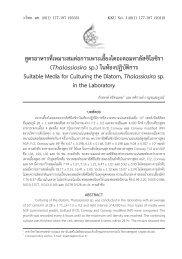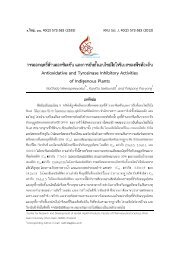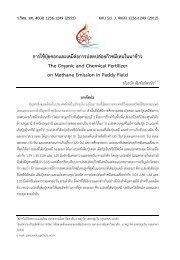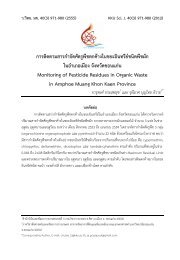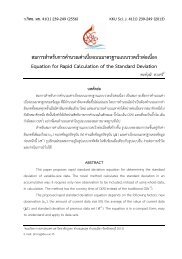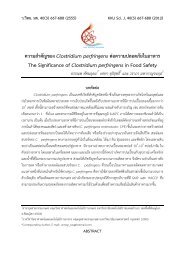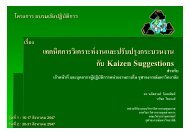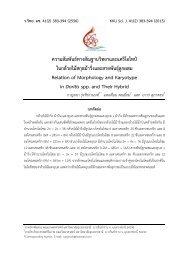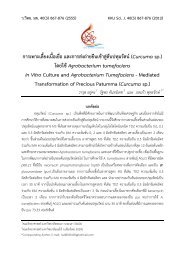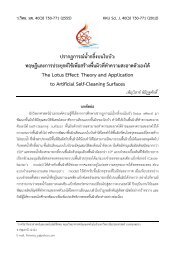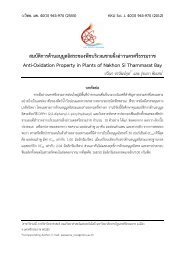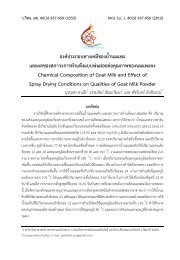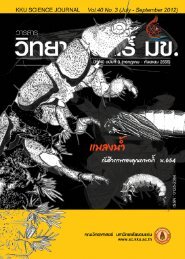Review
Review
Review
You also want an ePaper? Increase the reach of your titles
YUMPU automatically turns print PDFs into web optimized ePapers that Google loves.
ß“π«‘®—¬<br />
«“√ “√«‘∑¬“»“ µ√å ¡¢. ªï∑’Ë 39 ©∫—∫∑’Ë 1 115<br />
15, 20 and 25 mg/l. Suspension of protocorms<br />
were maintained at 25+2 ÌC, shaked at 110 rpm.<br />
Protocorms were cultured on VW semi-solid<br />
medium supplemented with chitosan 5, 10, 15, 20<br />
and 25 mg/l (30 explants were used for each<br />
treatments). Semi-solid culture medium were kept at<br />
25+2 ÌC and provided photoperiods of 16 h per day<br />
using cool white fluorescent. After 12 weeks, the<br />
number of the leaves, roots, shoots and the fresh<br />
weight (FW) of plant in semi-solid medium were<br />
measured. Only the fresh weight of plant in liquid<br />
medium was measured after 4 weeks of culturing.<br />
Transplantation of plantlets<br />
Plantlets of P. cornucervi (Breda) Blume<br />
& Rchb.f. were dipped into fungicide solution for<br />
15 min. They were then transferred to plastic basket<br />
(size 27.5x13.2x12.3 cm) containing of charcoal<br />
as planting material and watered with various<br />
concentrations of chitosan solution at 5, 10, 15, 20<br />
and 25 mg/l and kept under the plastic cover. The<br />
cover were occasionally removed after the second<br />
week to allow air circulation and to decrease the<br />
internal humidity. After 4 weeks, the percentage<br />
of survival was calculated using the formula as<br />
followed:<br />
% survival = number of plants survival x<br />
100/total number of plants<br />
Experimental design and data analysis<br />
Each experiment contained 30 explants was<br />
performed in a complete randomize design (CRD)<br />
and repeated twice. All data were analyzed by<br />
ANOVA and mean values were compared using<br />
Duncanûs Multiple Range Test (DMRT) at 5%<br />
significant level.<br />
Results and discussion<br />
Chitosan preparation<br />
The chitosan was yielded from cuttlebone<br />
in 20% (w/w) with 56% degree of deacetylation<br />
(DD). The results showed that cuttlebone chitosan<br />
had a lower degree of acetylation than brine shrimp<br />
chitosan (67-74%) (Tajik et al., 2008). The DD<br />
is an important parameter affecting solubility,<br />
chemical reactivity and biodegradability. It may range<br />
from 30-95% depending on the source and<br />
preparation procedure (Martino et al., 2005).<br />
Effect of chitosan on the growth of<br />
protocorm in liquid and semi-solid medium<br />
The results of chitosan on the growth of<br />
protocorms in liquid were showed in Table 1 and<br />
Figure 1. The protocorm (original weight 0.6 g) in<br />
the medium supplemented with chitosan at various<br />
concentrations; 5, 10, 15, 20 and 25 mg/l, were<br />
produced more in higher weight than in the control<br />
medium without chitosan. The effect of chitosan on<br />
growth of protocorms cultured on the semi-solid<br />
medium for 12 weeks was presented in Table 2.<br />
The results showed that the highest number of leaves<br />
(4.3 leaves), roots (2.5 roots) and shoots (1.5 shoots)<br />
could obtain when cultured on the medium with 15<br />
mg/l of chitosan. The result also showed that<br />
concentration of chitosan higher than 15 mg/l<br />
caused decreasing of growth and development of<br />
protocorm. It was reported that chitosan stimulated<br />
the development of Vitis vinifera L. (Barka et al.,<br />
2004). Pornpienpakdee et al. (2010) also reported<br />
that chitosan was found to enhance the in vitro<br />
micropropagation of Dendrobium ùEiskulû.



